Does Treatment for Heartworms Shorten a Dog’s Life Expectancy?
The Truth about Heartworms
Dirofilaria immitis, or heartworms, are found throughout most of the United States. Dogs come down with heartworm when bitten by a infected mosquito carrying the parasite’s microscopic larvae. If a dog is exposed to infected larvae, it’s a virtual certainty he’ll come down with heartworm disease. The number of heartworms infecting a dog can range from a single specimen to more than 250, according to the American Heartworm Society. They usually congregate in the heart’s right ventricle or the pulmonary arteries. Heartworms can reach a foot in length, living five years or more.
Does Your Dog Have Them?
It takes approximately seven months for larvae to grow to adulthood in a dog’s body. In the early stages of infestation, dogs are asymptomatic. As the heartworms grow, affected dogs develop a cough. Symptoms progress to include exercise intolerance and abnormal breathing. Signs of severe heartworm infestation include abnormal cardiac sounds, abdominal fluid accumulation and coma. Dogs might suddenly die.
Treatment Options
The U.S. Food and Drug Administration has approved two medications for heartworm eradication in canines. Thiacetarsamide sodium, an older treatment administered intravenously, can cause numerous side effects in dogs because of its toxicity. A newer drug, Melarsomine dihydrochloride, is injected intramuscularly deeply into the lumbar area.
What’s the Prognosis?
Once heartworm drugs are administered, the worms start dying off. The dead worms break into pieces, which can cause a pulmonary blockage in your dog, killing him. It’s crucial that dogs undergoing heartworm treatment remain calm and quiet both during the treatment and for months afterward. It’s not easy to keep a young dog confined with minimal exercise for long periods, but it’s the best way to keep heartworm bits from heading into the lungs. When treatment is over, your dog receives medication to kill off the baby heartworms, or microfilaria.
Heartworm Prevention
A monthly heartworm preventative in tablet form or topically applied can keep your dog free from the travails of heartworm disease. Your vet must take a blood sample to ensure your dog is heartworm-free before prescribing the medication. Depending where you live, heartworm tablets or medications are given seasonally or year-round.
Is It Possible to Change a Dog’s Life When It Has Been Abused?
The Learning Curve
Dogs are amazingly forgiving. Patience is key, however, especially in the beginning of your relationship. When you first bring a dog with a history of abuse home, he might hide under or behind objects or back away from you. Loud noises tend to startle, and be mindful of quick hand gestures, which can make him instinctively cower or snap. Set up a bed for him in a room where you spend the majority of your time, but in a corner far enough away so he feels a safe distance. Some dogs feel more secure in a dog crate.
Professional Training
An accredited trainer or behaviorist can help set up both your household and training routines to help a dog who’s been abused. An experienced trainer also will be able to adapt typical training methods to meet the dog where he is and help you chart progress. Although the details of a dog’s past are often unclear, if you know whether he was hurt by a child or a particular gender this can be helpful information for a trainer, especially when attempting to socialize him in public areas. Most veterinarians have working relationships with behaviorists and can recommend someone who can help.
The Trust Factor
A person’s first instinct when approaching a scared dog is often to move forward at the dog’s level with a handful of treats. This is a mistake made from a place of love and compassion. When a scared dog is approached, his first instinct might be to run away, or to bark or lunge in an effort to keep the human from getting closer. Wait for him to come to you. Let him watch you put down food and water, but do not make eye contact and calmly go about your routine. Let him see you are not anxious about his presence. Ignore him as he gets to know you by sniffing. This may not happen the first day, but when he feels safe enough to sit near you, he’s saying he’s ready to trust again.
A Positive Future
A rough start in life does not mean a dog cannot recover and adapt to a loving home. He might always have behavior quirks, or react in certain situations (regular exercise, such as walks, can relieve anxiety as well as strength your relationship with your dog). Your dog’s personality and the circumstances of his abuse will dictate the obstacles you have to cross, and you might have to change certain routines. With patience and proper training, you can change the lives of most dogs who have been abused.
How Can Owning a Dog Increase Life Expectancy?
Cardiovascular Health
Dog owners get more exercise just by taking their dog out for a walk. The American Heart Association says that 54 percent of dog owners are likely to get the recommended amount of exercise for good health. All this exercise lowers cardiovascular risks and cholesterol levels, making pet owners more healthy and more likely to live longer lives.
Lower Blood Pressure
Due to the calming effect petting a dog has on people, dog owners tend to have lower blood pressure than those who do not own pets. Dog owners lower blood pressure also may be due to the amount of exercise they get.
Socially Connected
Dogs can help you stay socially connected, which is vitally important for people who are at risk of social isolation. Walking with a dog often leads to more conversations and more connections with people. The National Institute of Health states that people who have more social contact and more friends live longer and are unlikely to decline as quickly as those who do not.
Anti-Depressant
Studies done at St. Louis University and Miami University by psychologists showed that pet owners were less likely to suffer from depression, had higher self-esteem and experienced less loneliness. When people see dogs, their brains release endorphins, which are natural antidepressants.
Visiting Therapists
Dogs are used more and more for therapy in hospitals. Although few studies have been done on therapy dogs and the effects on patients, most clinicians say they can see the benefits, according to the National Institutes of Health. Dogs help patients by reducing their anxiety and improving their mood. These benefits clearly help patients heal and may help improve the prognosis for their illness.
Will Canine Lupus Shorten a Dog’s Life?
Potentially Fatal
Lupus is a chronic disease meaning once Lucy has it, lifelong treatment will be necessary. She’ll have her good days and bad days as the disease goes into and comes out of remission. Becky Lundgren, D.V.M. wrote in her article “Systemic Lupus Erythematosus” for VeterinaryPartner.com that the disease is potentially fatal. Canine lupus is capable of shortening a dog’s life because it causes her immune system to attack her own tissues and cells. Occasionally the resulting cell damage can lead to death.
Difficult Diagnosis
Early diagnosis and treatment is the key to keeping lupus from affecting Lucy’s life span, but diagnosing it can be difficult. The symptoms are difficult to pin down because not all dogs show the same signs. Additionally, the ones you’ll notice, such as fever, lameness and skin and mouth sores will come and go. This can keep you from recognizing the condition as serious. Blood tests have to be done to confirm other symptoms such as anaemia, thyroiditis and antinuclear antibodies.
Prevention is Problematic
The cause of canine lupus isn’t known, although some factors have been suspected as having an effect on which dogs develop the disease. Lucy could be genetically predisposed to having canine lupus, or a viral infection or a drug reaction could bring it on. Because of the uncertainty surrounding the cause of lupus in dogs, there’s no sure-fire way to prevent any dog from getting it, other than keeping a dog who has it from breeding to avoid perpetuating the disease.
Caring for a Dog With Lupus
Treating Lucy’s lupus with immunosuppressive drugs and corticosteroids can reduce the chances of the disease damaging her tissues and cells. That can go a long way toward ensuring the illness won’t cut her life short. At home, you can do your part by encouraging rest during her flare-ups, even crating her if necessary to keep her from overexerting. Bright sunlight can increase the frequency of those flare-ups, so helping her to avoid intense sunlight is beneficial. Pet MD notes that if Lucy’s kidneys have been affected by the disease your vet likely will put her on a low protein diet, too.
Is There Such Thing As Dog Life Insurance?
It’s a Dog’s Life (Insurance)
It will take some digging and research, but it is possible to find life insurance for your dog. Traditional insurance companies, like the one your life or homeowner’s policy is through, usually don’t carry policies on dogs, even if they’re purebred. There are companies that specialize in pet insurance, however, and they’re the ones that can provide the coverage you’re looking for.
Who Should Get It
People who get life insurance for their dogs typically have expensive purebred pooches. Not all of them are show dogs, but many are, making insurance a common-sense issue. And because of the cost of a specially trained service dog, people who have these types of dogs sometimes choose to insure them, too.
Things to Consider
Life insurance for dogs doesn’t work exactly like life insurance for humans. You’ll have to shop around and find out what different policies cover and how they determine the payout. Some policies are written for accidental death only, and some will pay for costs like final veterinary expenses, euthanasia, cremation or burial. One insurance company might calculate the payout based on the market value of the dog at the time of his death, while another will base it on the price you paid for your dog. Ask about age cut-offs, too. Some insurance companies won’t insure dogs over a certain age and will even drop insurance once a dog reaches 10 or 11 years.
Other Dog Insurance
If life insurance on your pooch isn’t practical, consider getting help with healthcare to improve the quality of his life and possibly extend it. If you haven’t looked into it before, you might be surprised at the number of companies that offer health insurance for pets. Like your own health insurance, there are usually different levels of coverage ranging from wellness plans to accident coverage. It may not insure the life of your dog, but it can help defray the costs of medical treatment — which may end up literally being a life and death issue.
11 Ways to Include your Dog in Your Wedding, Without Your Dog
When I was planning my wedding around this time last year, I hemmed and hawed over including my beloved French Bulldog, Huggs. I’ve known him longer than my husband and he’s been there for me every step of my last 7 years, so there was no doubt I wanted him included, but the reality was it just didn’t make sense.
We traveled for our wedding and then headed out immediately for our honeymoon, but most importantly, the venue, an old house, with open doors to city streets, simply didn’t feel like a safe choice for a curious bulldog. Add these concerns to a dog who likes to eat things off the ground and who talks loudly when being ignored and has general anxiety over new things, my husband and I decided it would probably be best if Huggs stayed at home. But just because Huggs wasn’t there in person, didn’t mean he couldn’t be there in other meaningful ways.
Here are the 7 ways we incorporated Huggs into our big day:
1. We played this video for our guests at the cocktail hour. Since it was filmed ahead of time and at our house Huggs was a co-star. His debut happens in the middle of the video (around the 2 min mark and again at 3 min) for those who are just here to see the dog.
2. Wedding Website – Wedding websites are a great way to inform your guests about the day’s events, but are also a great opportunity to let guests know a little more about the bride and groom and things that are important to them. We included all of the traditional items, our story, about us, about the day and photos of us, but we were sure to give Huggs a special gallery all his own.
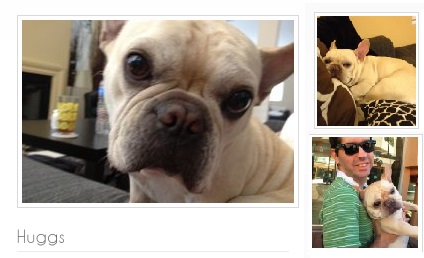
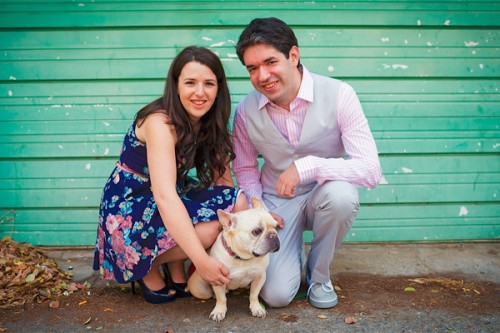
5. Marriage Contract – In Jewish weddings it is traditional to sign a ketubah, a Jewish wedding contract. It is signed before the wedding and then displayed during the event and is ultimately hung in your home. who offers beautiful options featuring unique and custom artwork. We selected one of the pieces already offered, but had them add in a couple special changes; one of which was a drawing of Mr. Huggs sitting on the hills of our Dr. Seuss-inspired ketubah.
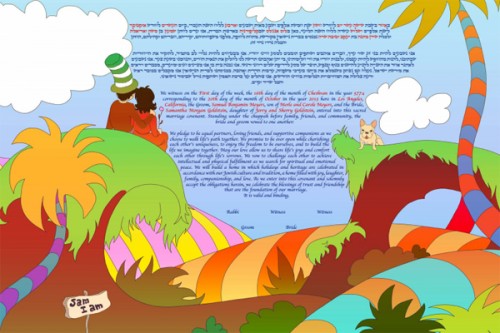
7. Cake Topper – Cakes and toppers have become more elaborate over the years, allowing brides and grooms to express their interests, passions and personalities. It’s a great place to add in a nod to your dog! I made our cake topper using clay, but there are plenty of places to order custom options if you don’t have the time to be crafty.

8. Include your dog in the invitations, save the dates or other paper goods like place cards, napkins and table numbers.
9. Theme your cake around your dog or include him in the design
10. Create a memorable wedding favor featuring your dog or give a gift that other dog-lover’s would enjoy
11. Create a dog-inspired cocktail to be served, if we had thought of this, we would have called ours the “Warm Hugg.”
With all these things added up, your dog can play a bigger part in the day then if he had walked down the aisle. Huggs got all the recognition he deserved while safe, sound and likely happier getting his snooze on at home.
Gross! My Dog Drinks from the Toilet!
You hear that familiar slurp-slurp-slurp of your dog drinking water … except it’s not coming from the direction of your dog’s water bowl. Instinctively, you head toward the bathroom, peek inside and yes, that’s right: there is your dog happily lapping up water from the toilet like you purposely left it open for him as a treat.
Sigh. Life with dogs.
Sure, drinking from the toilet is kind of amusing. (I mean, come on! He’s drinking from the toilet!) And yes, it’s really disgusting. (I mean, come on. He’s drinking from the toilet.) So why do dogs do this peculiar behavior?
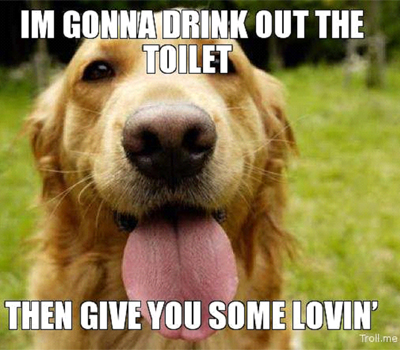
Why Do Dogs Drink from the Toilet?
Two words: fresh water. Ignore, for a moment, the pesky detail that this supposedly “fresh” water is coming from a place where humans — well, you know. To your dog, a toilet is a convenient place where fresh, cool water is abundant and readily available. That bowl of water you just put out for your dog? Stagnant and old, according to your dog. When you think about it, it’s actually kind of smart to choose the seemingly fresher choice in the large porcelain bowl over the one in the small bowl that’s been sitting there who knows how long.
Another reason a dog might drink from the toilet: He finished the water in his water bowl, he’s still thirsty, and he’s in search of another source of water. Thirsty dog, meet toilet bowl.
Just How Bad is Toilet-drinking, Anyway?
According to the ASPCA Animal Poison Control Center website, “bacterial-related gastrointestinal problems could occur from drinking stagnant toilet water, so it is a good idea to discourage your dog from imbibing from the commode.” Toilet water could also be filled with household-cleaner chemicals and other junk you don’t want your dog drinking, especially if you just cleaned the toilet, or if you use drop-in toilet bowl cleaning tablets.
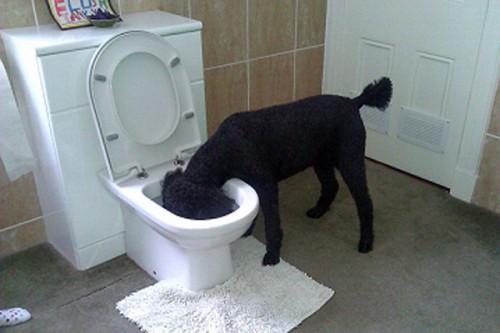
Craig Murphy/Flickr
Thankfully, if your dog drinks from a toilet that contains drop-in cleaners, it’s not likely to be a problem beyond stomach upset, assuming that you followed the cleaner label’s directions, according to the APCC. If your dog is showing signs of serious illness, contact your local veterinarian or call the APCC hotline at 888-426-4435.
How Can I Stop This Gross Behavior?
You don’t have to put up with potty drinking for long — you just have to modify your behavior first.
1. Leave the toilet lid down. This is one of those duh things that some people don’t do because it’s just so easy to forget. If the toilet water is inaccessible, then your dog can’t drink it. Of course, there are always those crafty canines that somehow manage to lift up the toilet lid anyway, which brings us to No. 2 on the list.
2. Close the bathroom door. If leaving the toilet lid down doesn’t deter your dog from drinking from the toilet, then close the bathroom door. This gives you the added bonus of keeping your dog out of the bathroom altogether and away from potentially poisonous or harmful chemicals, medicines and toiletries.
3. Keep your dog’s water bowl filled. Make sure your dog always has easy access to fresh, clean water. A dog who turns up his nose at water that has been sitting stagnant for days (or even hours) will probably go in search of a fresher alternative (read: the toilet). Also, a dog who is a big drinker might finish his water before his thirst is quenched, so be on the lookout for an empty water bowl, and fill it accordingly.
4. Try a gadget or gizmo. If all else fails and your dog still craves a taste of the toilet, there are products available that might help, including automatic water bowls and fountains that keep the water circulating and fresh. You could also try installing a toilet-seat lid locks, which will let you easily use the toilet but fasten shut when not in use.





